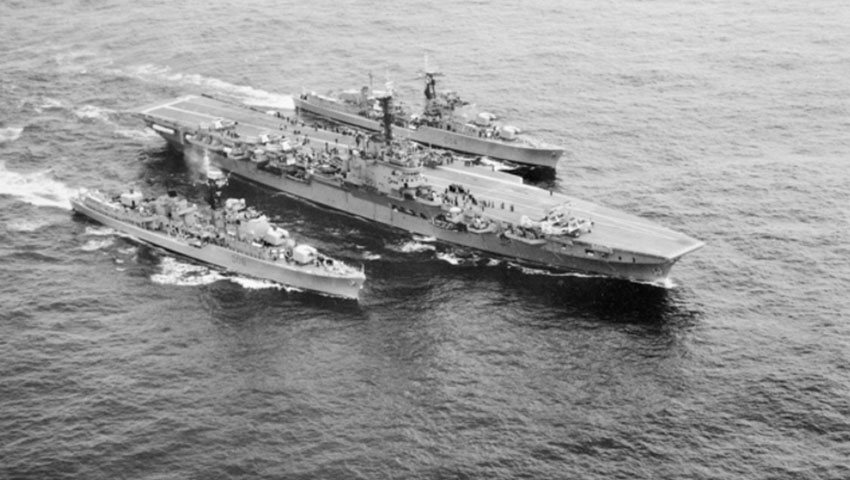As the war in the Pacific drew to a close, Australia emerged traumatised by the ferocity and effectiveness of the Japanese advance. With a new threat on the horizon, Australia embraced a policy of “the best defence is a good offence” in a policy of ‘Forward Defence’.
To continue reading the rest of this article, please log in.
Create free account to get unlimited news articles and more!
Japan's blitzkrieg through south-east Asia and successful routing of both British and American forces throughout both the region and wider Pacific served as a confronting wake up call for Australia.
The young nation was, for the first time, exposed to direct attack and to the prospect of invasion of the mainland, which would dramatically impact Australia's post-war defence doctrine and capabilities.
As Australia's primary security relationship shifted from the British Empire to the triumphant United States at the end of the war, the growing threat of communism in the region, driven by the successful Chinese revolution in 1949 and the following Korean crisis saw Australian forces drawn into direct conflict with former North Korean and Chinese forces.
In response to this perfect storm of external global factors, Australia's leaders sought to confront potential threats to the nation by engaging them away from continental Australia to avoid any repeat of the Papua New Guinea campaign or any direct attack against Australian cities as had occurred numerous times throughout the Pacific campaign.
The Domino Theory
The fall of China to Mao's communists in 1949 followed by the invasion of South Korea in mid-1950 by the Soviet and Chinese-backed forces of Kim Il Sung served to intensify the tensions between the East and West.
Growing domestic concern about the threat of communism in south-east Asia and the mounting arms race between the US and the Soviet Union served to amplify Australia's fears about the threat of a 'red' invasion, leading to Australia's direct involvement as part of the United Nations force in Korea, as well as playing a pivotal role in responding to the Malayan Emergency and curbing a growing insurgency on Australia's doorstep.
A decade of strife on the Malayan peninsula beginning in 1950 resulted in Australia establishing and maintaining a forward deployed force based at RAAF Base Butterworth as part of the British-led Far East Strategic Reserve, entrenching Australia's position as a regional security benefactor committed to maintaining peace and stability in the region.
The outbreak of the Konfrontasi between Indonesia and Malaysia in the early-1960s equally served to highlight the inherent instability and volatility of south-east Asia, with the potential for extensive impact on Australia's national and economic security. Again, Australia's intervention to subdue a regional conflict that posed a threat to strategically critical sea lines of communication reinforced the necessity for a robust Australian presence in the region.
Better to fight them over there, rather then fighting them over here
As domestic fear grew early into the early 1960s, the Australian government of the day initiated a policy of 'Forward Defence' focused on south-east Asia. The government announced a large increase in defence spending and the Australian Army would be increased by 50 per cent over three years, from 22,000 to 33,000 through the introduction of the National Service Act.
The Navy's two aircraft carriers, HMA Ships Sydney and Melbourne, were supported by a series of three American-designed and built destroyers, six frigates, anti-submarine helicopters, and the venerable Oberon Class submarines, while the Air Force also saw an extensive period of modernisation, with a focus on long-range strike and conventional deterrence capabilities.
Air Force's acquisition of new Mirage fighter aircraft, F-111 strike aircraft, C-130 Hercules and P-3 Orion maritime reconnaissance and anti-submarine patrol aircraft rounded out the Australian Defence Force's plans for a force designed to serve a strategic deterrence and expeditionary focused force capable of supporting and defending Australia's regional interests.
While a far cry from the superpower levels of force projection wielded by the US, Soviet Union and the European powers, Australia's ability to project presence forward into south-east Asia underpinned a policy of strategic engagement and partnership building at the regional level.
The pen working with the sword
Strategic partnerships and alliances as always served as a key force multiplier for Australia, particularly relationships with the US, namely in the form of the ANZUS Treaty signed in 1954 and the Five Power Defence Agreement.
It was Australia's position as a key US and UK ally in the region and the broader global battle against communism that placed the nation at the centre of both great power's strategic planning in the Indo-Pacific providing avenues for enhanced military-to-military co-operation, uniform platform acquisition as part of the modernisation and upgrade of Australia's defence capabilities, among other advantages.
These formalised relationships served to enhance both Australia's regional relationships and the nation's broader security apparatus, establishing a form of 'great power' insurance, similar to that which was established at the height of the British Empire.
The nation's conduct throughout both the Second World War and into the early-decades of the Cold War established Australia as a responsible and reliable partner, committed to the security of the wider region not only for the US and British, but more broadly for regional partners seeking protection from potential insurgencies. It was this relationship and the nation's growing position as a 'loyal deputy' to the US that would serve to reshape the nation's strategic policy heading into the second half of the 20th century.
In the next part, we will take a closer look at the impact of Australia's involvement in the Vietnam conflict and the decline of the Cold War as the world transitioned toward a unipolar world, dominated by the United States and a period of asymmetric challenges and humanitarian interventions which served to shape the nation's strategic policy and doctrine into the new millennium.

 Login
Login







